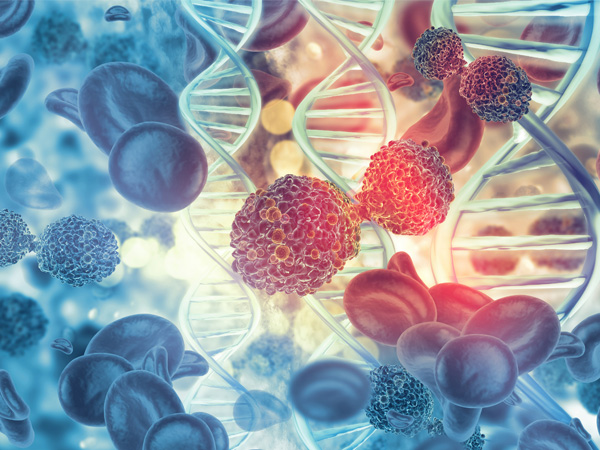- Home
- Science
- Diseases & Conditions
- Prostate Cancer
What Is Prostate Cancer?
Prostate cancer is a type of cancer that forms in the prostate, a gland situated before the rectum and under the bladder. Part of the reproductive system in individuals assigned male at birth, the prostate produces fluid contained in semen. With prostate cancer, cells in this organ grow uncontrollably.1 The majority of prostate cancers don’t spread to other areas of the body. Prostate cancer cells may spread to other parts of the body if left untreated.
Prostate Cancer Prevalence
In the U.S., prostate cancer is the second-most common cancer in people with prostates (following skin cancer) and the second leading cause of cancer death (following lung cancer). According to the American Cancer Society, approximately 1 in 44 people with prostates die of prostate cancer, but most people who are diagnosed with prostate cancer survive. More than 3.3 million people currently living in the U.S. have been diagnosed with prostate cancer at some point in their lives.2
Roughly 313,780 people in the U.S. will be diagnosed with prostate cancer in 2025, according to estimates from the American Cancer Society, and 35,770 will die from the disease.2 Fortunately, overall prostate cancer survival rates have improved in recent decades. The current five-year survival rate is 100 percent for localized prostate cancer. However, five-year survival rates for people with prostate cancer that has spread to other areas of the body is about 37 percent.3
Causes and Risk Factors

What Causes Prostate Cancer?
Prostate cancer is caused by changes in the DNA of normal prostate cells. Scientists still don't know exactly why this happens, but research has identified several genetic mutations and risk factors that may contribute to its development.4
Prostate Cancer and Genetics
Cancers are caused by genetic mutations—DNA changes that have the potential to turn normal, healthy cells into abnormal, cancerous ones.4 Many genetic mutations related to cancer occur in genes involved in managing cell growth.4 For example, within the body, normal genes known as proto-oncogenes help cells divide.5 This helps existing cells stay alive and allows the body to create new cells when needed.5 Certain genetic mutations can turn proto-oncogenes into a different type of gene that may cause cancer—these are known as oncogenes. Oncogenes interfere with the normal process of cellular division, causing cells to multiply without stopping. The uncontrolled growth of these cells may, in turn, lead to cancer.5
Another type of gene that helps manage cell growth is known as tumor suppressor genes. They help the body recognize when a cell is too old or damaged, causing the cell to die. Some genetic mutations turn off tumor suppressor genes, which may eventually cause cancer.4,6
Most genetic mutations that contribute to prostate cancer occur during a person’s lifetime and are not inherited or passed from one generation to the next. Acquired gene mutations may be random events that happen during normal cell division, or they may be linked to other factors such as diet or hormone levels.4
Doctors estimate that hereditary genetic mutations play a major role in up to 10% of prostate cancer cases. Cancer researchers have discovered several inherited gene mutations that are associated with prostate cancer, including mutations in tumor suppressor genes and in genes that normally repair damaged DNA. More rarely, a gene that helps in the formation of the prostate gland may mutate, causing early-onset prostate cancer.4
Prostate Cancer Risk Factors
According to the Centers for Disease Control and Prevention, about 13% of Americans with prostates will develop this cancer at some point, and 2% to 3% will die from the disease.7 However, certain demographic, lifestyle, and environmental factors can increase risk, including:
According to the American Cancer Society, about 60% of new prostate cancer diagnoses are in people older than age 65. The disease is rarely found in people with prostates younger than age 40, but risk increases rapidly after age 50.8
Black people with prostates are more likely to get prostate cancer and are more than twice as likely to die from it. They also tend to get prostate cancer at a younger age and be diagnosed at a more advanced stage. Caribbean people of African ancestry with prostates are also at increased risk, while Asian American and Hispanic people with prostates are less likely than non-Hispanic white people with prostates to get prostate cancer.7,8
The risk for hereditary prostate cancer is greater for those who have a first-degree relative who has prostate cancer, those who were diagnosed with prostate cancer at age 55 or younger, or those with other family members diagnosed with breast, ovarian, or pancreatic cancer.7
Other Factors
The following factors may have some implications in prostate cancer risk, but are not as clear:8
- Weight
Obesity does not seem to increase the overall risk of getting prostate cancer, but some studies suggest it could increase the odds of being diagnosed with a more aggressive form of the disease.8
- Smoking
So far, there is no clear link between getting prostate cancer and a history of smoking. However, some studies suggest that smoking may increase the risk of dying from prostate cancer. Smoking does increase the risk of other types of cancers.8
- Exposure to certain chemicals
Some studies suggest that firefighters might be exposed to chemicals that increase the risk of prostate cancer. Agent Orange, a chemical weapon used during the Vietnam War, might also increase the risk.8
- Inflammation
Prostatitis (inflammation of the prostate gland) is often found in samples of cancerous prostate tissue. So far, there is no concrete evidence of the role of prostatitis in prostate cancer development, but its potential role as a risk factor is under investigation. Researchers are also trying to determine whether sexually transmitted infections, such as gonorrhea or chlamydia (which can inflame the prostate), might increase cancer risks.8
Prostate Cancer Prevention
Many prostate cancer risk factors, like your age or family history, cannot be controlled or changed. However, taking steps to adopt a healthy lifestyle could help prevent prostate cancer. Doctors generally recommend staying healthy by:9
- Maintaining a healthy weight
- Being physically active
- Consuming a healthy diet with a variety of colorful fruits and vegetables and whole grains and limiting red meat, sugary drinks, and foods (including meats) that are highly processed.
Types of Prostate Cancer
Doctors classify cancers by type based on where the cancer first formed in the body. The vast majority of prostate cancers are adenocarcinomas—cancers that form in glandular cells. In the prostate, these cells are responsible for making fluid that is part of semen.10
Other forms of cancer that may begin in the prostate gland include:10
- Sarcomas
- Small cell carcinomas
- Transitional cell carcinomas
- Other neuroendocrine tumors
Prostate Cancer Symptoms

Different people experience different prostate cancer symptoms. Many people with prostates experience no symptoms at all before diagnosis. Prostate cancer symptoms may include:11
- Difficulty starting urine flow
- Weak or interrupted urine flow
- Urinating more frequently than usual, especially at night
- Difficulty fully emptying the bladder
- Painful urination or burning sensation
- Blood present in urine or semen
- Prolonged pain in the back, pelvis, or hips
- Pain during ejaculation
Many prostate cancer symptoms could be caused by other health problems, but it's important to see a doctor right away when experiencing signs of prostate cancer or having any concerns.11 As with other cancers, prostate cancer may be more treatable if caught early.
Diagnosis and Treatment
- Prostate Cancer Screening
Doctors may be able to find prostate cancers early using different types of screening techniques. Prostate-specific antigen (PSA) testing measures blood levels of PSA. Higher than normal levels of PSA, a substance made by the prostate, may indicate the presence of cancer or other conditions affecting the prostate.12 Although there are clear benefits to screening if cancer is found, prostate cancer screening can also lead to false-positive results and overdiagnosing and is therefore not always recommended.13
The American Cancer Society recommends that for people with prostates, the discussion for screening should take place at14:
- Age 50 for people who are at average risk of prostate cancer and expect to live at least another 10 years.
- Age 45 for people who are at high risk of developing prostate cancer, including those who have a first-degree relative (such as a father or brother) who were diagnosed with prostate cancer under the age of 65, as well as Black people with prostates.
- Age 40 for people at even higher risk, such as those with more than one first-degree relative with a prostate cancer diagnosis at any early age.
New tests based on other forms of PSA, or other types of biomarkers, are also being developed, including the Prostate Health Index (PHI), 4Kscore test, and SelectMDx, among others.15,16 - Prostate Cancer Diagnosis
If PSA results or other screening examinations suggest that cancer might be present, a urologist may perform a prostate biopsy. During a biopsy, the urologist removes a small piece of tissue from the prostate. The tissue sample goes to a laboratory where a pathologist can examine it under a microscope for the presence of cancer cells. This helps doctors make a prostate cancer diagnosis.15
- How Prostate Cancer Is Graded
For those with prostate cancer, doctors will use the results of the PSA test, biopsy, and additional imaging tests to determine what type of cancer it is and the stage of its growth.15,17
First, the cancer tissue will be assigned a grade using the Gleason system, which measures how much the cancer resembles normal prostate tissue. A Gleason grade of 1 means it looks a lot like normal tissue, while a grade of 5 means it looks very abnormal. Because prostate tumors typically have areas with different grades, the pathologist will assign different grades to the two areas that make up most of the cancer, then add those numbers to produce a Gleason score. For example, if most of the tumor is grade 3 and the rest is grade 5, the total Gleason score is 8.15
The Gleason score tells the doctor whether the cancer is:15
- Low-grade: Gleason score of 6 or less
- Intermediate-grade: Gleason score of 7
- High-grade: Gleason scores of 8 to 10
Additionally, doctors developed prostate cancer Grade Groups to help further differentiate cancers based on Gleason scores.15Grade Group 1 is the lowest group, describing prostate cancers that are more likely to grow and spread to other tissues slowly. In contrast, Grade Group 5 describes prostate cancers that typically grow and spread quickly.15
Prostate cancer Grade Groups include:
- Grade Group 1 = Gleason 6 (or less)
- Grade Group 2 = Gleason 3+4=7
- Grade Group 3 = Gleason 4+3=7
- Grade Group 4 = Gleason 8
- Grade Group 5 = Gleason 9-10
- Prostate Cancer Stages
After receiving a prostate cancer diagnosis, a healthcare team will need to determine the cancer's stage, or how much cancer is in the body, to decide the best course of treatment. Prostate cancer stages are based on five key pieces of information:17
- The size of the tumor
- Whether it has spread to nearby lymph nodes
- Whether the diagnosis is metastatic prostate cancer, meaning it has spread to other parts of the body
- PSA level at the time of diagnosis
- Grade group based on the Gleason score
There are four stages of prostate cancer:17- Stage 1 prostate cancer. The cancer has not reached lymph nodes or other parts of the body. PSA level is less than 10 and Gleason score is 6 or less.
- Stage 2 prostate cancer. Cancer has not spread to lymph nodes or other parts of the body. For subtypes of Stage 2A, Gleason scores are 6 or less. For Stage2 B and Stage 2 C, Gleason scores can be 7 or 8. For all subtypes of Stage 2, PSA scores range between 10-20.
- Stage 3 prostate cancer. In stages 3A, 3B, and 3C, cancer has not spread to lymph nodes or other parts of the body. For 3A and 3B, Gleason scores are 8 or less. For Stage 3C, Gleason scores can be 9 or 10. And PSA levels are at least 20 for Stage 3A, while any PSA score may occur with Stage 3B or 3C.
- Stage 4 prostate cancer. In Stage 4A, the cancer has reached lymph nodes but has not reached other parts of the body. It can have any Gleason score and any PSA level. In Stage 4B, the cancer may or may not have reached nearby lymph nodes, but it has reached other parts of the body. It can also have any Gleason score and any PSA level.
Cancer stages indicate how advanced the cancer is and help doctors identify appropriate treatment options.17
Prostate Cancer Treatment
Once cancer has been diagnosed and staged, the patient and doctors will decide together which prostate cancer treatment is right. A care plan could include the following approaches.
- Expectant Management for Prostate Cancer
In some cases, doctors recommend postponing treatment for prostate cancer. Instead, they wait to see if the condition worsens—this is called watchful waiting. During the watchful waiting period, doctors withhold treatment while closely monitoring the patient’s condition. This period continues until the patient begins to show signs or symptoms of prostate cancer.18
Doctors may also suggest active surveillance—close monitoring of prostate health with regular PSA tests and biopsies. Treatment begins when the cancer begins to grow.18
- Surgery for Prostate Cancer
Prostate cancer surgery may involve a prostatectomy to remove some or all of the prostate.19 In some cases, treatment involves a radical prostatectomy to remove the entire prostate and surrounding tissues.18
- Radiation Treatment for Prostate Cancer
Radiation therapy for prostate cancer uses high-energy rays to eliminate cancer cells. There are two main types of radiation therapy:18
- External radiation therapy, which uses a machine to direct radiation at cancer cells
- Internal radiation therapy, where seeds or catheters are placed into or near the cancer to destroy the cells
- Chemotherapy for Prostate Cancer
Chemotherapy stops the growth of cancer cells either by causing cell death or halting cell division. Depending on which drug is used, chemotherapy medications may be administered orally or via injection into muscle tissue or veins.18
- Hormone Therapy for Prostate Cancer
Hormone therapy removes or blocks hormones to stop the growth of cancer cells. One approach to hormone therapy is called androgen deprivation therapy (ADT). In ADT, doctors use hormones, drugs, or surgery to reduce the amount of male sex hormones or prevent them from functioning. Hormone therapy for prostate cancer may involve:18
- Antiandrogen drugs, which can reduce androgens in the body by preventing androgen production (androgen biosynthesis inhibitors) or blocking androgen receptors (androgen receptor inhibitors)18,20,21
- Orchiectomy surgery to remove one or both testicles and decrease testosterone production18
- Drugs to prevent testicles from making testosterone18
- Targeted Therapy for Prostate Cancer
Targeted therapy for prostate cancer uses drugs or other molecules to preferentially single out and act on cancerous cells.18
- Immunotherapy for Prostate Cancer
Immunotherapy harnesses the body’s natural defenses—the immune system—to fight cancer. Doctors may administer a cancer vaccine to prompt the immune system to start destroying cancer cells.22,23
Checkpoint inhibitors are also sometimes used to help boost the body’s immune response. They work by targeting “checkpoint” proteins on immune cells, which can switch the immune response on or off. Checkpoint inhibitors can be used to treat cancers with specific genetic changes in their cells, although these changes are not common in prostate cancer.23
- Bone-targeted therapy
When prostate cancer spreads to other areas of the body, it almost always spreads to the bones first. Bone-targeted therapy may treat prostate cancer that has spread to bones, which can lead to broken bones, pain, and other issues. If the patient is on certain bone-targeted therapies, a doctor may recommend taking vitamin D or calcium to prevent calcium levels from dropping too low. Bone-targeted therapy may help to stop the cancer while also reducing pain and other complications.24
- Prostate Cancer Treatments Under Investigation
As we learn more about prostate cancer, researchers are investigating new treatments and therapies that could benefit many people.
If you’re interested in exploring a clinical trial, ask your doctor which ones may be right for you.
Global Impact of Prostate Cancer
Prostate cancer is the most frequently diagnosed cancer in people with prostates in the majority of countries worldwide (118 of 185).25 In people assigned male at birth, prostate cancer was the fifth highest cause of cancer death globally in 2020.25,26 According to global prostate cancer statistics, there are an estimated 1.5 million new cases diagnosed every year.25 In 2022, the most recent year data was available, there were an estimated 397,430 deaths from the disease.26
Mortality rates for prostate cancer have dropped in the majority of high-income countries since the mid-1990s, thanks to better screening through PSA testing and advancements in treatment. However, during the same time, death rates increased within countries in Asia, Africa, and Central and Eastern Europe, where testing and treatments may be limited.27

Frequently Asked Questions About Prostate Cancer
- What is the prostate cancer survival rate?
Prostate cancer that is localized (contained to the prostate) or regional (has only spread to nearby lymph nodes and structures) typically has a five-year survival rate of greater than 99%. Distant prostate cancer that has metastasized to parts of the body farther from the prostate (such as the lungs, liver, or bones) has a five-year survival rate of 37%.28
- Is prostate cancer curable?
There are many therapies for prostate cancer, including investigational therapies in clinical trials. Treatability depends on factors including the patient's age and overall health and how advanced the cancer is when diagnosed.18
- Can women get prostate cancer?
Anyone with a prostate can get prostate cancer.1
- How common is prostate cancer?
Roughly 13% of Americans with prostates will develop prostate cancer during their lifetimes.7
- How do I get screened for prostate cancer?
If prostate cancer symptoms are present or an individual is at risk, a doctor may perform a prostate cancer screening.14 Screening usually includes a prostate-specific antigen (PSA) test that measures blood levels of PSA.12 New tests based on other forms of PSA, or other biomarkers, are also being developed. If PSA testing suggests that cancer might be present, a urologist may perform a prostate biopsy.15
- If I’m diagnosed with prostate cancer, where do I begin?
If you’re diagnosed with prostate cancer, your doctor will use the results of your PSA test, biopsy, and additional imaging tests to determine what type of cancer it is and the stage of its growth.15,17 Once your doctor determines the cancer's stage, or how far it has spread, you’ll work together to decide the best course of treatment.17
Learn More About Prostate Cancer
Find Pfizer clinical trials for prostate cancer at PfizerClinicalTrials.com.
Explore prostate cancer clinical trials at ClinicalTrials.gov.
Area of Focus: Oncology
Prostate Cancer is a focus area for Pfizer Oncology. To learn more about how we’re accelerating breakthroughs to outdo cancer, visit the Oncology page.
Find resources for those living with cancer and their caregivers at This is Living with Cancer.
- References
- Prostate cancer basics. Centers for Disease Control and Prevention. https://www.cdc.gov/prostate-cancer/about/index.html. Updated August 27, 2024. Accessed April 14, 2025.
- Key statistics for prostate cancer. American Cancer Society. https://www.cancer.org/cancer/prostate-cancer/about/key-statistics.html. Updated January 16, 2025. Accessed April 14, 2025.
- Cancer stat facts: Prostate cancer. National Cancer Institute. https://seer.cancer.gov/statfacts/html/prost.html. Accessed April 14, 2025.
- What causes prostate cancer? American Cancer Society. https://www.cancer.org/cancer/prostate-cancer/causes-risks-prevention/what-causes.html. Updated November 22, 2023. Accessed April 14, 2025.
- Oncogenes, tumor suppressor genes, and DNA repair genes. American Cancer Society. https://www.cancer.org/cancer/understanding-cancer/genes-and-cancer/oncogenes-tumor-suppressor-genes.html. Updated August 31, 2022. Accessed April 21, 2025.
- Tumor suppressor genes. Cleveland Clinic. https://my.clevelandclinic.org/health/body/24833-tumor-suppressor-genes. Updated March 16, 2023. Accessed April 21, 2025.
- Prostate cancer risk factors. Centers for Disease Control and Prevention. https://www.cdc.gov/prostate-cancer/risk-factors/. Updated August 27, 2024. Accessed April 14, 2025.
- Prostate cancer risk factors. American Cancer Society. https://www.cancer.org/cancer/prostate-cancer/causes-risks-prevention/risk-factors.html. Updated November 22, 2023. Accessed April 14, 2025.
- Can prostate cancer be prevented? American Cancer Society. https://www.cancer.org/cancer/prostate-cancer/causes-risks-prevention/prevention.html. Updated November 22, 2023. Accessed April 14, 2025.
- What is prostate cancer? American Cancer Society. https://www.cancer.org/cancer/prostate-cancer/about/what-is-prostate-cancer.html. Updated November 22, 2023. Accessed April 14, 2025.
- What are the symptoms of prostate cancer? Centers for Disease Control and Prevention. https://www.cdc.gov/prostate-cancer/symptoms/?CDC_AAref_Val=https://www.cdc.gov/cancer/prostate/basic_info/symptoms.htm Updated August 27, 2024. Accessed April 14, 2025.
- Screening for prostate cancer. Centers for Disease Control and Prevention. https://www.cdc.gov/prostate-cancer/screening/?CDC_AAref_Val=https://www.cdc.gov/cancer/prostate/basic_info/screening.htm. Updated August 27, 2024. Accessed April 14, 2025.
- Can prostate cancer be found early? American Cancer Society. https://www.cancer.org/cancer/types/prostate-cancer/detection-diagnosis-staging/detection.html. Updated November 23, 2023. Accessed April 14, 2025.
- American Cancer Society recommendations for prostate cancer early detection. American Cancer Society. https://www.cancer.org/cancer/types/prostate-cancer/detection-diagnosis-staging/acs-recommendations.html. Updated November 22, 2023. Accessed April 14, 2025.
- Tests to diagnose and stage prostate cancer. American Cancer Society. https://www.cancer.org/cancer/prostate-cancer/detection-diagnosis-staging/how-diagnosed.html. Updated November 22, 2023. Accessed April 14, 2025.
- What’s new in prostate cancer research? American Cancer Society. https://www.cancer.org/cancer/types/prostate-cancer/about/new-research.html. Updated December 10, 2024. Accessed April 14, 2025.
- Prostate cancer stages. American Cancer Society. https://www.cancer.org/cancer/prostate-cancer/detection-diagnosis-staging/staging.html. Updated November 22, 2023. Accessed April 14, 2025.
- Prostate cancer treatment (PDQ®)–patient version. National Cancer Institute. https://www.cancer.gov/types/prostate/patient/prostate-treatment-pdq#section/_142. Updated December 20, 2024. Accessed April 14, 2025.
- Prostatectomy. Cleveland Clinic. https://my.clevelandclinic.org/health/treatments/24294-prostatectomy. Updated October 9, 2022. Accessed April 14, 2025.
- Hormone therapy for prostate cancer. American Cancer Society. https://www.cancer.org/cancer/prostate-cancer/treating/hormone-therapy.html. Updated November 22, 2023. Accessed April 14, 2025.
- Rice MA, Malhotra SV, Stoyanova T. Second-generation antiandrogens: from discovery to standard of care in castration resistant prostate cancer. Front Oncol. 2019;9:801.
- Venkatachalam S, McFarland TR, Agarwal N, Swami U. Immune checkpoint inhibitors in prostate cancer. Cancers. 2021;13(9):2187.
- Immunotherapy for prostate cancer. American Cancer Society. https://www.cancer.org/cancer/prostate-cancer/treating/vaccine-treatment.html. Updated November 22, 2023. Accessed April 14, 2025.
- Treatments for prostate cancer spread to bones. American Cancer Society. https://www.cancer.org/cancer/prostate-cancer/treating/treating-pain.html. Updated November 22, 2023. Accessed April 14, 2025.
- Global Cancer Facts & Figures: 5th Edition. American Cancer Society. https://www.cancer.org/content/dam/cancer-org/research/cancer-facts-and-statistics/global-cancer-facts-and-figures/global-cancer-facts-and-figures-2024.pdf. Accessed April 14, 2025.
- Mortality, both sexes, in 2022. Cancer today. Global Cancer Observatory. World Health Organization. https://gco.iarc.fr/today/en/dataviz/tables?types=1&mode=cancer&group_populations=1&sort_by=value1&multiple_populations=1. Accessed April 14, 2025.
- Sung H, Ferlay J, Siegel RL, et al. Global cancer statistics 2020: Globocan estimates of incidence and mortality worldwide for 36 cancers in 185 countries. CA: A Cancer Journal for Clinicians. 2021;71(3):209-249. doi:10.3322/caac.21660. https://acsjournals.onlinelibrary.wiley.com/doi/10.3322/caac.21660. Accessed April 14, 2025.
- Survival rates for prostate cancer. American Cancer Society. https://www.cancer.org/cancer/prostate-cancer/detection-diagnosis-staging/survival-rates.html. Updated January 16, 2025. Accessed April 14, 2025.
The information contained on this page is provided for your general information only. It is not intended as a substitute for seeking medical advice from a healthcare provider. Pfizer is not in the business of providing medical advice and does not engage in the practice of medicine. Pfizer under no circumstances recommends particular treatments for specific individuals and in all cases recommends consulting a physician or healthcare center before pursuing any course of treatment.




